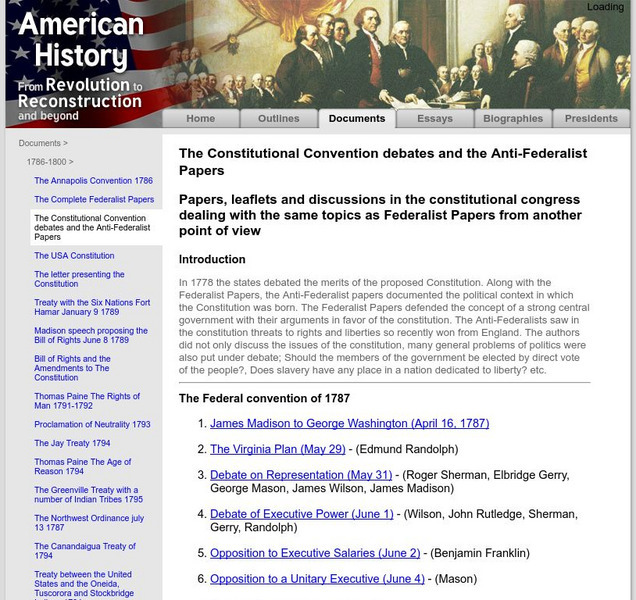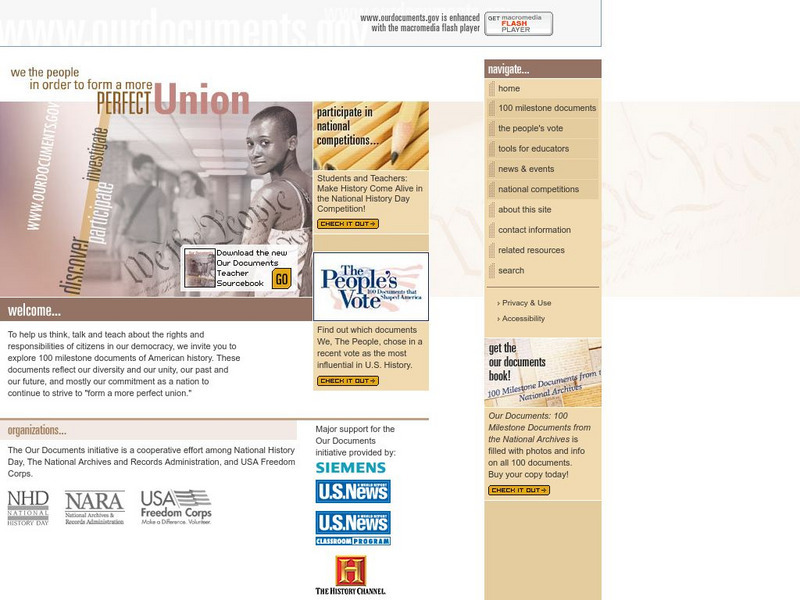National Endowment for the Humanities
Background on the Patriot Attitude toward the Monarch
Learners explain the Patriot attitude toward the British monarchy, which helps them embrace the Founders' reluctance to have a strong executive under the Articles of Confederation as well as their desire to build in checks of executive...
Judicial Branch of California
The Constitution: What It Says and What It Means
Learners get the chance to act as representatives to the Constitution Convention, and must decide whether or not to recommend your state ratify the new framework. After examining the Constitution line-by-line, they consider their...
Curated OER
Arguments Against Ratifying the Constitution
Young scholars define federalism, Federalist, and Anti-Federalist, debate issue of ratification in classroom convention, and take vote on whether to add bill of rights. Three lessons on one page.
Curated OER
The Philadelphia Convention/Constitutional Convention
Eleventh graders explore the major points covered during the Philadelphia Convention/Constitutional Convention. They discuss the Federalists and the Anti federalists. They discuss the Bill of Rights and the drafting of the Constitution....
National Endowment for the Humanities
The President Under the Articles of Confederation
The Articles of Confederation sounds like one big, fancy title to middle schoolers. Here, scaffolded steps help to ease novices into understanding this all-important American document. Discussion questions, lesson activities, and ideas...
Curated OER
Fine Tuning a Nation: Using Cartoons
Students examine political cartoons to gain an understanding of the political issues that George Washington faced. In this historical perspectives lesson, students analyze political cartoons about the National Bank, the title presidents,...
Curated OER
The Mayflower Compact
Eighth graders investigate historical documents of the United States by reading the Mayflower Compact. In this U.S. History activity, 8th graders analyze the wording of the original Mayflower Compact of the first U.S. settlers and...
Curated OER
The Beginnings of Constitutional Government
Students examine excerpts of Thomas Paine's Common Sense. For this early American history lesson, students read Paine's pamphlet and analyze the information according the rubric provided.
Curated OER
Constitutional Convention
Students engage in a role-playing situation to illustrate the kinds of compromised that were made a teh Constitutional Convention. They write three short 1-2 paragraph arguments and then present their arguments to the class at the...
University of Groningen
American History: Documents: The Anti Federalist Papers
This resource presents a user-friendly index of the Anti-federalist papers, leaflets and discussions in the Constitutional Congress. These items demonstrate how the Anti-Federalists saw the constitution as a threat to rights and...
Ohio Test Prep
Ohio Test Prep: Federalist Papers and Anti Federalist Papers
Ohio test prepartion material provides three videos from which students compare the arguments of the federalists and anti-federalists.
C3 Teachers
C3 Teachers: u.s. History Module: Did Founders Want Government to Work? [Pdf]
A comprehensive learning module on the system of government established by the founders that includes three supporting questions accompanied by formative tasks and primary source materials, followed by a summative performance task....
iCivics
I Civics: Federalists & Anti Federalists
Look at the debate and eventual compromise, between the Federalists and Anti-Federalists that occurred around the creation of the U.S. Constitution.
Khan Academy
Khan Academy: Federalist No. 70
This study resource from Khan Academy discusses the Federalist No.70. This information is intended for students taking high school or college level American Government and Civics courses, including the AP Government course.
University of Groningen
American History: Outlines: A New Kind of Federalism
Overview of the reasons and purposes of a Federalist government in which federal and state governments share concurrent powers as proposed and outlined in the Federalist Papers.
Digital History
Digital History: The Debate Over Ratifying the Constitution [Pdf]
Read about why ratification of the United States' new constitution was such a struggle. Find arguments for and against ratification, and discover who supported the Federalist position and who the Anti-Federalist position. [PDF]
University of Groningen
American History: Biographies: Alexander Hamilton
This site is provided for by the University of Groningen. Alexander Hamilton represented the growing movement towards a strong national government. Read the beginning stages of the nationalist movement, the conflicting ideas of state...
History Tools
History Tools: Centinel Criticizes the Proposed Constitution [Pdf]
Historical document excerpt written in opposition to federalist proposal, October, 1787. Argued against the formation of a federal government and criticized the proposed Constitution. Numbered paragraphs added and spelling modernized.
University of Missouri
Exploring Constitutional Conflicts: The Constitutional Convention of 1787
One word can sum up the Constitutional Convention of 1787 - compromise. Find out which compromises were made and by which groups of people and/or states. This expansive site includes background on the convention, primary source...
Khan Academy
Khan Academy: Brutus No. 1
This resource from Khan Academy provides the full text of Brutus I. This lesson is intended for students taking high school or college level American Government and Civics courses, including the AP Government course.
US National Archives
Nara: Charters of Freedom: Constitution of the United States
Comprehensive overview of the U.S. Constitution. Places the Constitution in context with two other founding charters of American democracy and government, the Declaration of Independence and the Bill of Rights. Includes access to digital...
US National Archives
Our Documents: A National Initiative on American History, Civics, and Service
Our Documents is home to one hundred milestone documents that influenced that course of American history and American democracy. Includes full-page scans of each document, transcriptions, background information on their significance, and...
Digital History
Digital History: Ratifying the Constitution
After the Constitution was written, debated, and finally adopted by the Constitutional Convention, it was sent to the states to ratify. Read about the fears of those who did not want to ratify it and see how their fears were addressed.
Wikimedia
Wikipedia: United States Bill of Rights
This encyclopedia article from Wikipedia gives some background history to the creation of the Bill of Rights and contains a transcription of the first ten amendments to the Constitution in their original form.











![C3 Teachers: u.s. History Module: Did Founders Want Government to Work? [Pdf] Unit Plan C3 Teachers: u.s. History Module: Did Founders Want Government to Work? [Pdf] Unit Plan](https://static.lp.lexp.cloud/images/attachment_defaults/resource/large/FPO-knovation.png)







